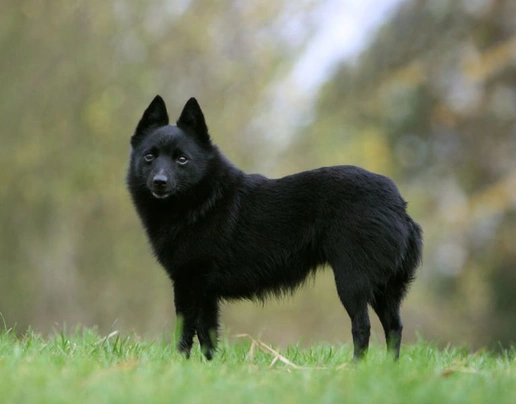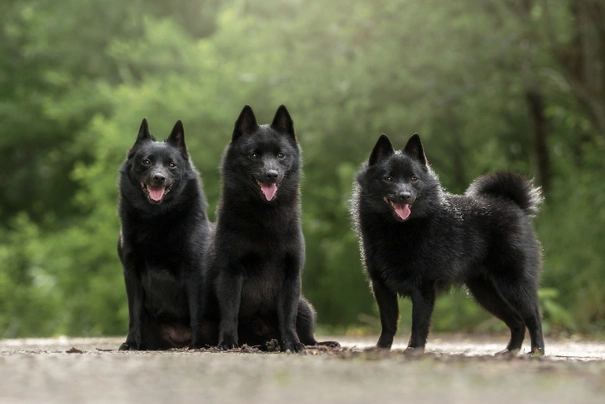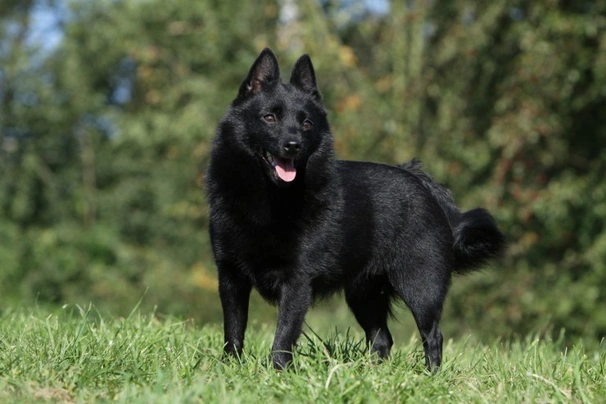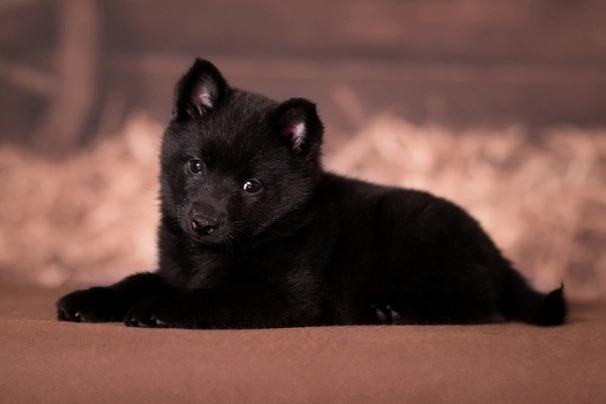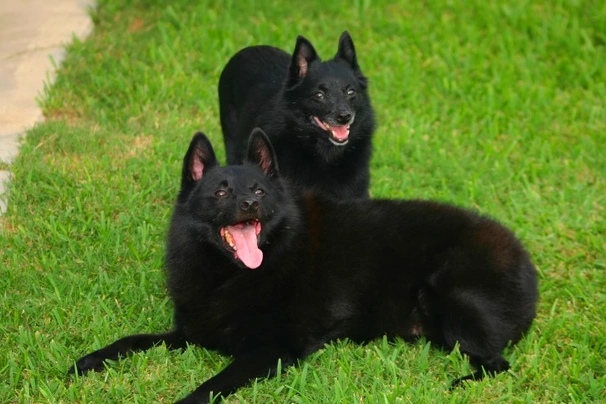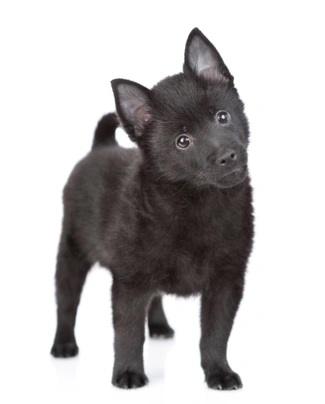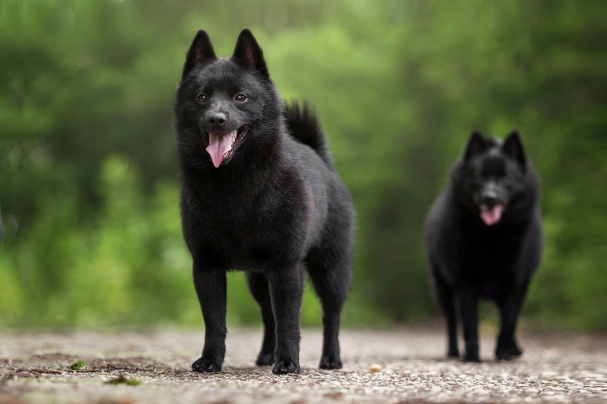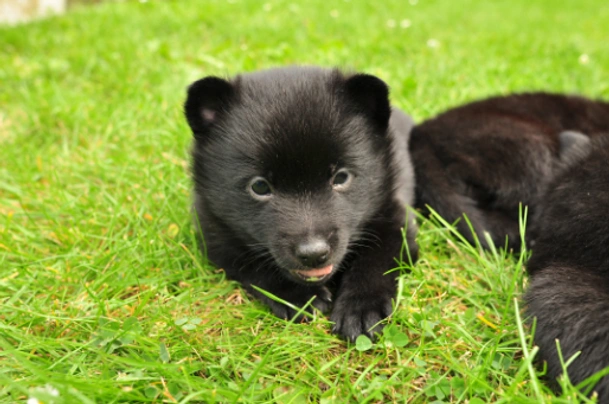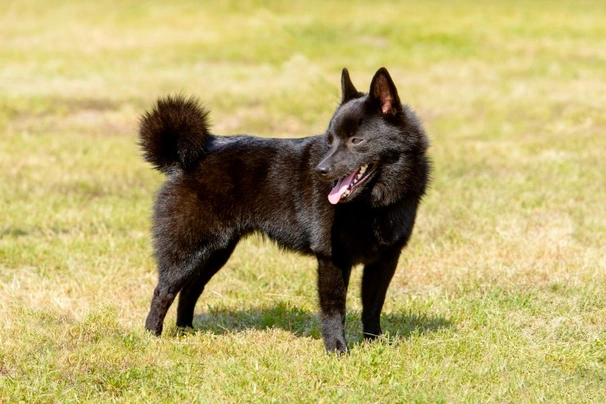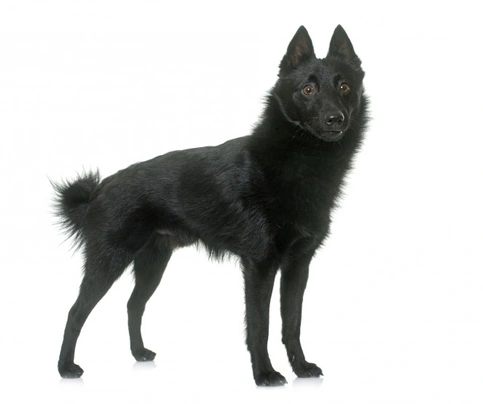Schipperke
Pros
Cons
Introduction of the Schipperke
The Schipperke is among the smallest of the Spitz-type breeds being native to both Belgium and the Netherlands where they have always been highly prized "canal dogs" because they were so skilled at guarding barges. They are not so well known in other parts of the world even though they are known to be affectionate and loyal companions and family pets. With this said their breed numbers are slowly rising with more people becoming aware of these charming and devoted little dogs.
Because breed numbers are still quite low in the UK and few well-bred puppies are registered with the Kennel Club every year anyone wishing to share their home with a Schipperke would need to register their interest with breeders and agree to being put on a waiting list for the pleasure of doing so with the good news being the wait would be well worth it.
History of the Schipperke
The Schipperke is an old breed and one that was developed in Belgium and the Netherlands where they have always been used to guard barges and canal boats a job these little dogs proved to be excellent at. They were also very popular with Flemish cobblers who would parade their dogs on Sundays and they were exhibited at a “one-breed” speciality show in 1690 when the shoe-makers guild organised an event that was held in Brussels’ Grand Place.
The breed is thought to be a descendant of a Leauvenaar a black sheepdog which is the same foundation breed for the Belgian Sheepdog. However the Schipperke was bred to be a small guard dog unlike their Belgian Sheepdog cousins. They were originally called Spitske or Spits but were given their new name Schipperke when a breed club was established back in 1888. Translated Schipperke means "little captain" or "little shepherd".
The breed first gained popularity when Queen Marie Henriette took a fancy to one of these charming dogs when they were being exhibited at a dog show held in Brussels in 1885. Three years later the breed was imported to the United States and in 1929 a breed club was founded over there. The first breed standard was drawn up in 1859 and thirty years or so later the Schipperke was officially recognised as a breed in its own right. During the Second World War these charming and unusual dogs were often used by the resistance to carry messages between underground bases and hideouts without the Nazis knowing about it. Later a Schipperke was featured in one of Beatrix Potter's stories "The Pie and the Patty Pan".
Today although not as widely popular as other breeds the Schipperke has earned the reputation of being a highly intelligent affectionate and loyal companion. However anyone wishing to share their homes with one of these fascinating little dogs would need to register their interest with breeders and agree to being put on a waiting list for the pleasure of doing so.
Interesting facts about the breed
- Is the Schipperke a vulnerable breed? No they have found a large fanbase in the UK thanks to their adorable looks and energetic personalities
- Schipperkes are known to be “big” dogs in “small” dog bodies
- A Schipperke was featured in one of Beatrix Potter's stories "The Pie and the Patty Pan"
- During the Second World War Schipperkes were used by the resistance to carry messages
- Queen Marie Henriette of Belgium was a big fan of the breed
- Schipperke means "little captain" or "little shepherd"
- They are often referred to as being “the best house dogs” and that they have “a real affinity with children”
- Traditionally a Schipperke’s tail was always docked but since the law banning the procedure came into effect in 2007 tail docking is now illegal with the exception being for some working breeds and if a dog suffers from some sort of health issue that requires their tails to be docked. The procedure must be agreed and authorised before being performed by a qualified vet failure to have the correct paperwork would result in heavy fines
- Some Schipperkes have naturally bobbed tails which is recorded on their Kennel Club registration documents
Appearance of the Schipperke
Height at the withers: Males 28 - 33 cm Females 25 - 30 cm
Average weight: Males 3 - 9 kg Females 3 - 9 kg
The Schipperke is a small energetic and cobby looking dog and one that boasts having a bit of a foxy look about them. They are always alert and ready to let people know when there are strangers about which is why they have always been so highly prized as watchdogs. They have quite broad flat skulls without a prominent stop. Their muzzles are moderately long and fine being nicely filled under a dog's eyes. Noses are small and black in colour and their eyes are a dark brown being more oval in shape than round. The Schipperke always has a bright and very expressive look about their eyes.
They have moderately long ears which are not that broad at the base but they taper to a point at the tips. Dogs carry their ears very erect. The Schipperke has a strong jaw with a perfect scissor bite where their upper teeth neatly overlap their lower ones. Their necks are full strong and slightly arched being a bit on the short side and set well into a dog's shoulders. Front legs are straight being well under a dog's body and showing a good amount of bone in proportion to the rest of their bodies.
Their chests are deep and broad with dogs having straight strong short backs and powerful loins. Their hindquarters are lighter than their forequarters and their back legs are muscular boasting well developed thighs. Rumps are nicely rounded and their feet are very cat-like being small with dogs standing well up on their toes. Tails are held tightly curled over the back and are well covered in hair. Some dogs are born without tails which is natural.
When it comes to their coat the Schipperke boasts having a profuse harsh dense coat with the hair on their heads ears and legs being smoother than on the rest of their bodies. Their coats are close lying on their backs and sides of their bodies but thicker and standing more erect around a dog's neck which forms a distinct frill and mane. Schipperkes have "culottes" on the back of their thighs on their back legs. The accepted breed colours for Kennel Club registration are as follows:
- Black
- Cream
- Gold
It is worth noting that the accepted breed colours for Kennel Club registration can differ from those set out in the breed standard which are as follows:
- Black is the usual coat colour
It is worth noting that Schipperkes with other solid colours are allowed under their breed standard.
Gait/movement
When a Schipperke moves they take short brisk strides always moving straight and true in their forequarter and hindquarters.
Faults
The Kennel Club frowns on any exaggerations or departures from the breed standard and would judge the faults on how much they affect a dog's overall health and wellbeing as well as their ability to perform.
Males should have both testicles fully descended into their scrotums and it is worth noting that a dog can be a little lighter or heavier as well as slightly taller or shorter than set out in the Kennel Club breed standard which is only given as a guideline.
Temperament of the Schipperke
The Schipperke is a smart little dog and one that forms very strong ties with their owners. They thrive on being in a family environment and will protect their owners with vigour if they ever feel they are being threatened. They are courageous devoted little dogs that love to know what is going on around them which is just one of the reasons they have always been such popular watch dogs.
They are energetic characters by nature and need to be kept busy but once tired a Schipperke is just as happy to relax and chill out on a sofa with their owner. They do not like being left on their own for long periods of time and are best suited to families where at least one person stays at home when everyone else is out. They are not the best choice for first time owners but are a great choice for people who are familiar with the specific needs of this type of high energy intelligent dog.
They never really grow up until they are around 4 or 5 years old remaining very "puppy-like" right up until then. They are very outgoing and confident as well as being extremely inquisitive by nature which often sees them finding ways to open doors. They can be a little strong willed at times which can make training them a bit of a challenge. They are also very suspicious and wary of people they don't know but rarely would a Schipperke show any sort of aggressive behaviour towards a stranger preferring to keep their distance and letting their owners know there are people about. However if they ever feel threatened in any way a Schipperke would not think twice about taking someone on regardless of their size.
It's really important for these dogs to be well socialised from a young age so they grow up to be confident outgoing mature dogs. Their socialisation has to include introducing them to lots of new situations noises people other animals and dogs once they have been fully vaccinated. It's also crucial for their training to start early too and it has to be consistent throughout a dog's life. A Schipperke is never happier than when they know their place in the pack and who they can look to for direction and guidance. If they don't know who the alpha dog in a household is they may quickly take on the role of dominant dog which can make them harder to live with and handle.
Are they a good choice for first time owners?
Schipperkes are not the best good choice for first time dog owners even though they are so amenable and people-oriented because they can get the better of anyone who is too soft with them allowing them to get their own way too often. This can result in a Schipperke taking on a more dominant role making them wilful and harder to manage.
What about prey drive?
Schipperkes have a very high prey drive and will happily ignore a command to chase anything they spot in the distance or an animal that tries to run away from them. As such great care must be taken as to where and when a Schipperke can run off the lead more especially if there is livestock and/or wildlife close by.
What about playfulness?
Schipperkes have a very playful side to their natures and love to entertain and be entertained. They are known to be a little mischievous when the mood takes them and being so clever they quickly learn how to please an owner and how to get their own way when they want something. As previously mentioned Schipperkes mature slowly remaining very puppy-like and playful until they are around 4 to 5 years old and then well into their senior years.
What about adaptability?
Schipperkes are highly adaptable dogs and providing they are given enough daily physical exercise combined with as much mental stimulation to prevent boredom from setting in they are just as happy living in an apartment in town as they would be living in a house in the country.
What about separation anxiety?
Although Schipperkes form strong ties with their families and are known to suffer from separation anxiety when left on their own for any length of time. No dogs are happy when they find themselves left on their own for longer periods of time which can lead to them being destructive around the home which is a dog's way of relieving any stress they are feeling and a way to keep themselves entertained which includes incessant barking bearing in mind that Schipperkes love barking anyway.
What about excessive barking?
Schipperkes like the sound of their own voices a little too much which is something that needs to be gently nipped in the bud when a dog is still young being careful not to frighten them. However even with the best training it can be hard to stop a Schipperke from voicing an opinion about something when they feel like it.
Do Schipperkes like water?
Most Schipperkes like swimming and will take to the water whenever they can more especially when the weather is hot. However if anyone who owns a dog that does not like water should never force them to go in because it would just end up scaring them. With this said care should always be taken when walking a Schipperke off the lead anywhere near more dangerous watercourses just in case a dog decides to leap in and then needs rescuing because they cannot get out of the water on their own.
Are Schipperkes good watchdogs?
Schipperkes are always on the alert which means they are natural watchdogs and will guard and protect their owners and their property. However rarely would a Schipperke show any sort of aggressive behaviour preferring to stand their ground and bark.
Intelligence / Trainability of the Schipperke
The Schipperke is a smart dog and a fast learner. The downside to this is they are just as quick to pick up bad habits as they are the good. Their training has to begin early bearing in mind that these clever little dogs can be a little stubborn and mischievous at times. Their training also has to be consistent and always fair throughout a dog’s life so they understand what their owner expects of them.
The key to successfully training a Schipperke is to make their training as interesting as possible and to avoid too much repetition. It's also a good idea to keep training sessions short which helps dogs stay more focussed on what it’s being asked of them bearing in mind that the more intelligent a dog is the faster they get bored and these little black dogs are extremely smart.
They do not answer well to harsh correction or any sort of heavy handed training methods but they do respond extremely well to positive reinforcement which always brings the best out of these intelligent and quick-witted dogs especially when there are high value rewards involved.
Schipperke puppies like all puppies are incredibly cute which means that it is all too easy to spoil them when they first arrive in their new homes. However once a puppy is nicely settled in new owners must start out as they mean to go on to prevent any behavioural problems from developing. Laying down ground rules and boundaries helps a puppy understand acceptable behaviour and what is not. It also helps establish a “pecking order” and who the alpha dog is in the household. The first commands a puppy should be taught are as follows:
- Come
- Sit
- Stay
- Heel
- Quiet
- Leave it
- Down
- Bed
Children and other
Schipperkes are known to be good around children thanks to their kind albeit lively natures. However any interaction between toddlers and a dog should always be well supervised by an adult to make sure playtime does not get too boisterous which could end up with someone being knocked over and hurt albeit by accident. They can be a little wary of children they don't already know which means care has to be taken when the kids have any friends over to play.
When dogs have been well socialised from a young enough age they generally get on well with other dogs they meet but care has to be taken if any dogs come into their environment because Schipperkes tend to be extremely territorial. If they have grown up with a family cat in a household they usually get on well together. However a Schipperke would think nothing of chasing off any other cats they encounter because they would see them as fair game. Care has to be taken when they are around any smaller animals and pets as such any contact is best avoided.
Health of the Schipperke
The average life expectancy of a Schipperke is between 12 and 15 years when properly cared for and fed an appropriate good quality diet to suit their ages.
The Schipperke is known to suffer from a few hereditary health issues which are worth knowing about if you are planning share your home with one of these active and good-looking dogs. The conditions that seem to affect the breed the most include the following:
- Mucopolysaccharidosis (MPSIIIB) – all dogs must be DNA tested
- Progressive retinal atrophy (PRA) – dogs should be tested annually
- Epilepsy
- Hypothyroidism
- Patellar luxation
- Legg Calve Perthes disease
- Cataract
- Autoimmune thyroiditis
It is worth noting that the breed average COI with The UK Kennel Club currently stands at 9.6%.
What about vaccinations?
Schipperke puppies would have been given their initial vaccinations before being sold but it is up to their new owners to make sure they have their follow-up shots in a timely manner with the vaccination schedule for puppies being as follows:
- 10 -12 weeks old bearing in mind that a puppy would not have full protection straight away but would be fully protected 2 weeks after they have had their second vaccination
There has been a lot of discussion about the need for dogs to have boosters. As such it's best to talk to a vet before making a final decision on whether a dog should continue to have annual vaccinations which are known as boosters.
What about spaying and neutering?
A lot of vets these days recommend waiting until dogs are slightly older before spaying and neutering them which means they are more mature before undergoing the procedures. As such they advise neutering males and spaying females when they are between the ages of 6 to 9 months old and sometimes even when a dog is 12 months old.
Other vets recommend spaying and neutering dogs when they are 6 months old but never any earlier unless for medical reasons. With this said many breeds are different and it is always advisable to discuss things with a vet and then follow their advice on when a dog should be spayed or neutered.
What about obesity problems?
As with other breeds some Schipperkes gain weight after they have been spayed or neutered and it's important to keep an eye on a dog's waistline just in case they do. If a dog starts to put on weight it's important to adjust their daily calorie intake and to up the amount of exercise they are given. Older dogs too are more prone to gaining weight and again it's essential they be fed and exercised accordingly because obesity can shorten a dog's life by several years. The reason being that it puts a lot of extra strain on a dog's internal organs including the heart which could prove fatal.
What about allergies?
Schipperkes are not known to suffer from allergies but it's important for a dog to see a vet sooner rather than later if one flares up. Allergies can be notoriously hard to clear up and finding the triggers can be challenging. With this said a vet would be able to make a dog with an allergy more comfortable while they try to find out the triggers which could include the following:
- Certain dog foods that contain high levels of grains and other cereal-type fillers
- Airborne pollens
- Dust mites
- Environment
- Flea and tick bites
- Chemicals found in everyday household cleaning products
Participating in health schemes
All responsible Schipperke breeders would ensure that their stud dogs are tested for known hereditary and congenital health issues known to affect the breed by using the following scheme:
- DNA test for MPSIIIB
- Progressive retinal atrophy (PRA) – dogs should be tested annually
What about breed specific breeding restrictions?
As of October 2008 the Kennel Club records Schipperkes that are born with a naturally bobbed tail which is noted on their registration certificates. A certificate from a vet is required for the registration.
What about Assured Breeder Requirements?
The Kennel Club strongly recommends that all breeders use the following scheme on their dogs:
Caring for the Schipperke
As with any other breed Schipperkes need to be groomed on a regular basis to make sure their coats and skin are kept in top condition. They also need to be given regular daily exercise to ensure they remain fit and healthy. On top of this dogs need to be fed good quality food that meets all their nutritional needs throughout their lives.
Caring for a Schipperke puppy
Schipperke puppies are boisterous and full of life which means it's essential for homes and gardens to be puppy-proofed well in advance of their arrival. A responsible breeder would have well socialised their puppies which always leads to more outgoing confident and friendly dogs right from the word go. With this said any puppy is going to feel vulnerable when they leave their mother and littermates which must be taken into account. The longer a puppy can remain with their mother the better although it should never be for too long either.
It's best to pick a puppy up when people are going to be around for the first week or so which is the time needed for a puppy to settle in. Puppy-proofing the home and garden means putting away any tools and other implements that a boisterous puppy might injure themselves on. Electric wires and cables must be put out of their reach because puppies love chewing on things. Toxic plants should be removed from flowerbeds and the home too.
Puppies need to sleep a lot to grow and develop as they should which means setting up a quiet area that's not too out of the way means they can retreat to it when they want to nap and it's important not to disturb them when they are sleeping. It's also a good idea to keep "playtime" nice and calm inside the house and to have a more active "playtime" outside in the garden which means puppies quickly learn to be less boisterous when they are inside.
The documentation a breeder provides for a puppy must have all the details of their worming date and the product used as well as the information relating to their microchip. It is essential for puppies to be wormed again keeping to a schedule which is as follows:
- Puppies should be wormed at 6 months old
- They need to be wormed again when they are 8 months old
- Puppies should be wormed when they are 10 months old
- They need to be wormed when they are 12 months old
Things you'll need for your puppy
There are certain items that new owners need to already have in the home prior to bringing a new puppy home. It's often a good idea to restrict how much space a puppy plays in more especially when you can't keep an eye on what they get up to bearing in mind that puppies are often quite boisterous which means investing in puppy gates or a large enough playpen that allows a puppy the room to express themselves while keeping them safe too. The items needed are therefore as follows:
- Good quality puppy or baby gates to fit on doors
- A good well-made playpen that's large enough for a puppy to play in so they can really express themselves as puppies like to do
- Lots of well-made toys which must include good quality chews suitable for puppies to gnaw on bearing in mind that a puppy will start teething anything from when they are 3 to 8 months old
- Good quality feed and water bowls which ideally should be ceramic rather than plastic or metal
- A grooming glove
- A slicker brush or soft bristle brush
- Dog specific toothpaste and a toothbrush
- Scissors with rounded ends
- Nail clippers
- Puppy shampoo and conditioner which must be specifically formulated for use on dogs
- A well-made dog collar or harness
- A couple of strong dog leads
- A well-made dog bed that's not too small or too big
- A well-made dog crate for use in the car and in the home that's large enough for a puppy to move around in
- Baby blankets to put in your puppy's crate and in their beds for when they want to nap or go to sleep at night
Keeping the noise down
All puppies are sensitive to noise including Schipperke puppies. It's important to keep the noise levels down when a new puppy arrives in the home. TVs and music should not be played too loud which could end up stressing a small puppy out making them withdrawn timid and shy.
Keeping vet appointments
As previously mentioned Schipperke puppies would have been given their first vaccinations by the breeders but they must have their follow up shots which is up to their new owners to organise. The vaccination schedule for puppies is as follows:
- 10 -12 weeks old bearing in mind that a puppy would not have full protection straight away but would only be fully protected 2 weeks after they have had their second vaccination
When it comes to boosters it's best to discuss these with a vet because there is a lot of debate about whether a dog really needs them after a certain time. However if a dog ever needed to go into kennels their vaccinations would need to be fully up to date.
What about older Schipperke when they reach their senior years?
Older Schipperkes need lots of special care because as they reach their golden years they are more at risk of developing certain health concerns. Physically a dog's muzzle may start to go grey but there will be other noticeable changes too which includes the following:
- Coats become coarser
- A loss of muscle tone
- They can either become overweight or underweight
- They have reduced strength and stamina
- Older dogs have difficulty regulating their body temperature
- They often develop arthritis
- Immune systems do not work as efficiently as they once did which means dogs are more susceptible to infections
- Older dogs change mentally too which means their response time tends to be slower as such they develop the following:
- They respond less to external stimuli due to impaired vision or hearing
- They tend to be a little pickier about their food
- They have a lower pain threshold
- Become intolerant of any change
- Often an older dog can feel disorientated
Living with a Schipperke in their golden years means taking on a few more responsibilities but these are easily managed and should include looking at their diet the amount of exercise they are given how often their dog beds need changing and keeping an eye on the condition of their teeth.
Older dogs need to be fed a good quality diet that meets their needs at this stage of their lives all the while keeping a close eye on a dog's weight. A rough feeding guide for older Schipperkes is as follows bearing in mind they should be fed highly digestible food that does not contain any additives:
- Protein content should be anything from 14 – 21%
- Fat content should be less than 10%
- Fibre content should be less than 4%
- Calcium content should be 0.5 – 0.8%
- Phosphorous content should be 0.4 – 0.7%
- Sodium content should be 0.2 – 0.4%
Older Schipperkes don't need to be given the same amount of daily exercise as a younger dog but they still need the right amount of physical activity to maintain muscle tone and to prevent a dog from putting on too much weight. All dogs need access to fresh clean water and this is especially true of older dogs when they reach their golden years because they are more at risk of developing kidney disorders.
Grooming of the Schipperke
The Schipperke boasts having a profuse double coat that consists of straight slightly coarse hair and a much softer denser undercoat. However they are low maintenance on the grooming front because all it takes is a weekly brush to keep their coats in good condition.
They shed throughout the year only more so during the Spring and then again in the Autumn when more frequent grooming is usually necessary to stay on top of things and to remove dead and loose hair from a dog's coat. It's also important to check a dog's ears on a regular basis and to clean them when necessary. If too much wax is allowed to build up it can lead to a painful infection which can be hard to clear up. In short prevention is often easier than cure with ear infections.
Exercise of the Schipperke
The Schipperke is a high energy intelligent dog and as such they need to be given the right amount of daily exercise and mental stimulation for them to be truly happy well-rounded dogs. They need to be given anything from 40 to 60-minutes exercise a day with as much off the lead time as possible. If they are not given the right amount of mental stimulation and exercise every day a Schipperke would quickly get bored and could even begin to show some destructive behaviours around the home which is their way of relieving any stress they are feeling and not necessarily because they are being naughty.
A shorter walk in the morning would be fine but a longer more interesting one in the afternoon is a must with as much off the lead time as possible. These dogs also like to be able to roam around a back garden so they can really let off steam. However the fencing has to be extremely secure to keep these active high-energy dogs in because if they find a weakness in the fence they will soon escape and could get into all sorts of trouble bearing in mind that these energetic little dogs are known to be extremely good escape artists loving nothing more than to dig.
With this said Schipperke puppies should not be over exercised because their joints and bones are still growing. This includes not letting a dog jump up and down from furniture or going up or down the stairs. Too much pressure placed on their joints and spines at an early age could result in a dog developing serious problems later in their lives.
Feeding of the Schipperke
If you get a Schipperke puppy from a breeder they would give you a feeding schedule and it's important to stick to the same routine feeding the same puppy food to avoid any tummy upsets. You can change a puppy's diet but this needs to be done very gradually always making sure they don't develop any digestive upsets and if they do it's best to put them back on their original diet and to discuss things with the vet before attempting to change it again.
Older dogs are not known to be fussy eaters but this does not mean they can be given a lower quality diet. It's best to feed a mature dog twice a day once in the morning and then again in the evening making sure it's good quality food that meets all their nutritional requirements. It's also important that dogs be given the right amount of exercise so they burn off any excess calories or they might gain too much weight which can lead to all sorts of health issues. Obesity can shorten a dog's life by several years so it's important to keep an eye on their waistline from the word go.
Feeding guide for a Schipperke puppy
Puppies need to be fed a highly nutritious good quality diet for them to develop and grow as they should. As a rough guide a Schipperke puppy can be fed the following amounts every day making sure their meals are evenly spread out throughout the day and it's best to feed them 3 or 4 times a day:
- 2 months old - 37g to 102g depending on a puppy's build
- 3 months old - 43g to 118g depending on a puppy's build
- 4 months old - 44g to 124g depending on a puppy's build
- 5 months old - 44g to 125g depending on a puppy's build
- 6 months old - 36g to 124g depending on a puppy's build
- 7 months old - 29g to 112g depending on a puppy's build
- 8 months old - 28g to 100g depending on a puppy's build
- 9 months old - 28g to 89g depending on a puppy's build
- 10 months old - 28g to 88g depending on a puppy's build
Once a puppy is 11 months old they can be fed adult dog food.
Feeding guide for an adult Schipperke
Once fully mature an adult Schipperke should be fed a good quality diet to ensure their continued good health. As a rough guide an adult dog can be fed the following amounts every day:
- Dogs weighing 3 kg can be fed 60g to 77g depending on activity
- Dogs weighing 4 kg can be fed 71g to 88g depending on activity
- Dogs weighing 5 kg can be fed 82g to 99g depending on activity
- Dogs weighing 6 kg can be fed 93g to 110g depending on activity
- Dogs weighing 7 kg can be fed 104g to 121g depending on activity
- Dogs weighing 8 kg can be fed 115g to 134g depending on activity
- Dogs weighing 9 kg can be fed 126g to 146g depending on activity
Schipperke price
If you are looking to buy a Schipperke you would need to register your interest with breeders and agree to being put on a waiting list because very few puppies are bred and registered with The Kennel Club every year. You would need to pay anything upwards of £400 for a well-bred pedigree puppy.
The cost of insuring a male 3-year-old Schipperke in northern England would be £19.02 a month for basic cover but for a lifetime policy this would set you back £41.75 a month (quote as of August 2016). When insurance companies calculate a pet's premium they factor in several things which includes where you live in the UK a dog's age and whether they have been neutered or spayed among other things.
When it comes to food costs you need to buy the best quality food whether wet or dry making sure it suits the different stages of a dog’s life. This would set you back between £20 - £30 a month. On top of this you need to factor in veterinary costs if you want to share your home with a Schipperke and this includes their initial vaccinations their annual boosters the cost of neutering or spaying a dog when the time is right and their yearly health checks all of which quickly adds up to over £800 a year.
As a rough guide the average cost to keep and care for a Schipperke would be between £50 to £80 a month depending on the level of insurance cover you opt to buy for your dog but this does not include the initial cost of buying a well-bred Kennel Club registered pedigree Schipperke puppy.
Buying advice
When visiting and buying any puppy or dog there are many important things to consider and questions to ask of the breeder/seller. You can read our generic puppy/dog advice here which includes making sure you see the puppy with its mother and to verify that the dog has been wormed and microchipped.
Schipperkes have a large fanbase in the UK which means that well-bred puppies can often command a lot of money. As such with Schipperkes there is specific advice questions and protocols to follow when buying a puppy which are as follows:
- Prospective owners may come across online and other adverts showing images of adorable Schipperke puppies for sale. However the sellers ask buyers for money up front before agreeing to deliver a puppy to a new home. Potential buyers should never buy a puppy unseen and should never pay a deposit to a seller before collecting a puppy from them
- As previously touched upon Schipperkes have a large fanbase in the UK and puppies can be expensive. As such some amateur breeders/people breed from a dam far too often so they can make a quick profit without caring for the welfare of the puppies their dam or the breed in general. Under Kennel Club rules a dam can only produce 4 litters and she must be between a certain age to do so. Anyone wishing to buy a Schipperke puppy should think very carefully about who they purchase their puppy from and should always ask to see the relevant paperwork pertaining to a puppy's lineage their vaccinations and their microchipping
- Prospective owners should be very careful when considering buying an extra small puppy because all too often they suffer from very serious health issues and no responsible breeder would purposefully breed dogs so they are too small
- Traditionally a Schipperke’s tail was always docked but since the law banning the procedure came into effect in 2007 tail docking is now illegal with the exception being for some working breeds and if a dog suffers from some sort of health issue that requires their tails to be docked. The procedure must be agreed and authorised before being performed by a qualified vet failure to have the correct documentation would result in heavy fines
- It is worth noting that some Schipperkes are naturally tailless. As of October 2008 the Kennel Club records Schipperkes that are born with a naturally bobbed tail which is noted on their registration certificates. A certificate from a vet is required for the registration.

